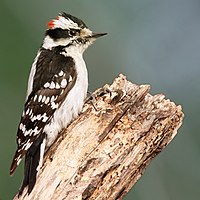Downy woodpecker
| Downy Woodpecker | |
|---|---|

| |
| Male | |
| Scientific classification | |
| Kingdom: | |
| Phylum: | |
| Class: | |
| Order: | |
| Family: | |
| Genus: | |
| Species: | P. pubescens
|
| Binomial name | |
| Picoides pubescens (Linnaeus, 1766)
| |

| |
| Synonyms | |
|
Dryobates pubescens | |
The Downy Woodpecker, Picoides pubescens, is the smallest woodpecker in North America. Adults are mainly black on the upper parts and wings, with a white back, throat and belly and white spotting on the wings. There is a white bar above and below the eye. They have a black tail with white outer feathers barred with black. Adult males have a red patch on the back of the head.

It is virtually identical in plumage pattern to the much larger Hairy Woodpecker. These species are not closely related at all, and they are likely to be separated in different genera (Weibel & Moore, 2005; Moore et al., 2006); the outward similarity is a spectacular example of convergent evolution. Why this is so cannot be explained with confidence; it certainly is interesting to note that the species exploit rather differently-sized foodstuffs and generally do not compete very much ecologically.
Their breeding habitat is forested areas, mainly deciduous, across most of North America to Central America. They nest in a tree cavity, excavated by the nesting pair in a dead tree or limb. The Downy Woodpecker can also be found east of Newfoundland and Labrador, on the islands of Saint-Pierre and Miquelon.
These birds are mostly permanent residents. Northern birds may migrate further south; birds in mountainous areas may move to lower elevations. Downy Woodpeckers roost in tree cavities in the winter.
Downy Woodpeckers forage on trees, picking the bark surface in summer and digging deeper in winter. They mainly eat insects, also seeds and berries. In winter, especially, Downy Woodpeckers can often be found in treed suburban backyards and will feed on suet at birdfeeders.
References
- Template:IUCN2006 Database entry includes justification for why this species is of least concern
- Moore, William S.; Weibel, Amy C. & Agius, Andrea (2006): Mitochondrial DNA phylogeny of the woodpecker genus Veniliornis (Picidae, Picinae) and related genera implies convergent evolution of plumage patterns. Biol. J. Linn. Soc. 87: 611–624. PDF fulltext
- Weibel, Amy C. & Moore, William S. (2005): Plumage convergence in Picoides woodpeckers based on a molecular phylogeny, with emphasis on convergence in downy and hairy woodpeckers. Condor 107(4): 797–809. doi:10.1650/7858.1 (HTML abstract)
Gallery
-
A male Downy Woodpecker eating from a suet feeder
-
Adult Male Downy Woodpecker. Ottawa, Ontario
External links
- Internet Bird Collection: Downy Woodpecker videos
- Downy Woodpecker - Picoides pubescens - USGS Patuxent Bird Identification InfoCenter
- Downy Woodpecker Species Account - Cornell Lab of Ornithology
- Downy Woodpecker Information and Photos - South Dakota Birds and Birding
- Downy Woodpecker photo gallery VIREO


